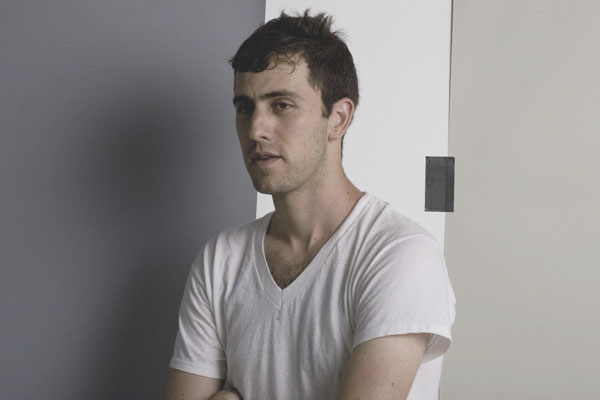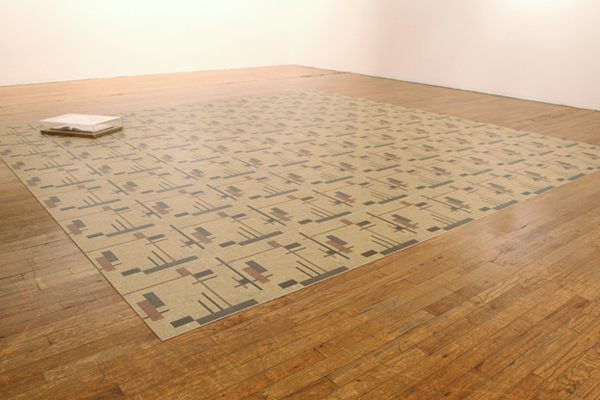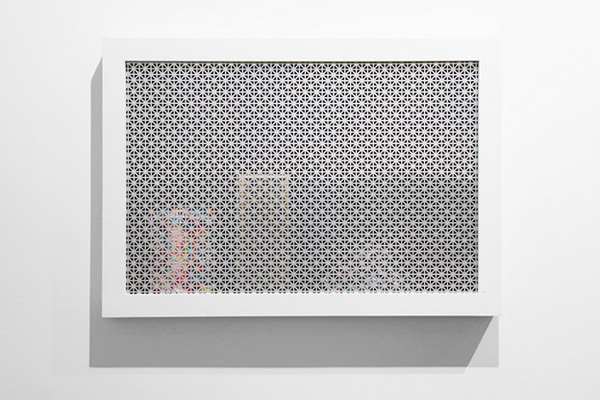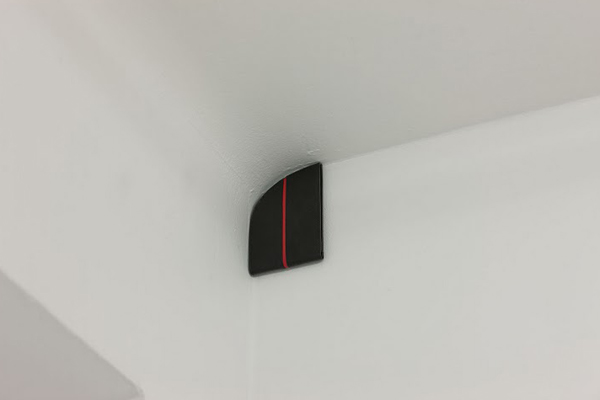
The 300-acre Brooklyn Navy Yard hosts ten contractors, forty-one distributors, and seventy-four manufacturers, one of whom is up-and-coming sculptor Zak Kitnick, whose 25' x 20' studio hides in a corner of the Big Apple Warehouse. "It's like this cube of bouillon, this very dense, very concentrated thing," says Kitnick of the art he produces in the small space, "but then at the drop of a hat you add water and it's soup for a hundred people." Does he have trouble getting pieces down the flight of stairs? "Those guys are awesome," said Kitnick, referring to Big Apple's employees.
The industrial setting matches Kitnick's work, which recreates and repurposes mass-produced material. Kitnick loves the "tension between buying and making. I won't make anything if it already exists." This winter at PS 1's "Between Spaces" Kitnick arranged 81 vinyl "accent tiles" in a square grid on the floor for a piece titled "About Working at PS 1." (pictured below)

According to Kitnick, the piece "was almost a Mondrian painting in this neutral palette. I love the idea of this gluttonous use of this accent tile: I feel like it's the fate of so much art to end up as mere decoration so maybe starting with this decorative source is a way to escape this." Kitnick's thoughts on decoration draw on Austrian architect Adolf Loos, whose 1908 article "Ornament and Crime" proclaimed, "the evolution of culture is synonymous with the removal of ornamentation from objects of everyday use." Kitnick scrambles the distinctions separating art, object, and ornament.
On the wall next to the grid was a series called "The People Behind Our Products," which consisted of shrine-like boxes housing a plastic bag, a map of the Navy Yard, and similar ephemera behind metal grates. "Ideally if someone were to look at this," says Kitnick of the series, "they would be able to say or think 'I could do that.' I want the work to seem approachable and familiar but strange - or not even strange, but just sometimes it's as simple as context."

"The People Behind Our Products" (pictured above) proves context's importance to Kitnick, who says he's "not interested in presenting an idea as much as in the idea of presentation." Only after making the piece did Kitnick remember an identical grate on the radiator in his studio: "When I first moved into this studio two and a half years ago there was that brass vent there and the first thing I did was cover it up with a piece of foamcore. Years later, I was thinking about this radiator as something that's meant to conceal something but at the same time not be seen, almost like a sort of camouflage. So after I started working with this I came back and cut the bottom off. I was like 'is that that?' It was there and it made me realize that these things that you hate in your studio you love in your work."
The same goes for "Actual Size," for which Kitnick installed two curved "Front Pocket Wallets" in opposite recesses of Malmö, Sweden's Johan Berggren Gallery. Kitnick noticed both the wallet and the M-shaped "Edge Baking Pan" in a SkyMall catalogue on the flight to Sweden. Though wallet, pan, and catalogue all made it into the show, Kitnick admits that he wouldn't carry such a "dorky" billfold himself.

Kitnick excitedly described a future project, based on a "top-loading gravity feed triple-column condiment dispenser" that offers a choice of three artificial sweeteners: pink Sweet 'n' Low, yellow Splenda, and sky blue Equal. The piece takes off on Hans Hacke's 1970 "MoMA Poll," which contained two Plexiglas ballot boxes underneath the prompt, "Question: Would the fact that Governor Rockefeller has not denounced President Nixon's Indochina policy be a reason for you not to vote for him in November? Answer: If 'yes' please cast your ballot into the left box, if 'no' into the right box." With the condiment dispenser, says Kitnick, "you have these columns of pastel pink, pale yellow, sky blue, and it's like a bar graph where the column with the lowest amount is the most popular. A lot of the work has to do with raising this question: is simply choosing or exerting some sort of preference a form of production or making?" --Jonah Wolf
For more arts-related stories, visit PAPERMAG.COM